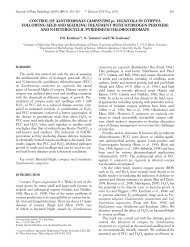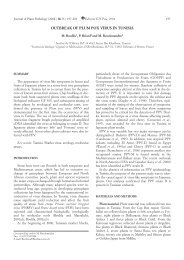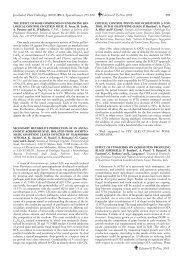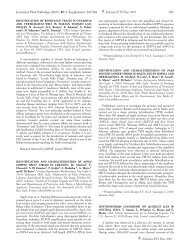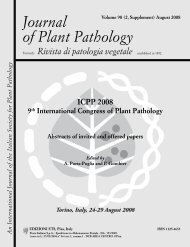Journal of Plant Pathology (2010), 92 (4, Supplement ... - Sipav.org
Journal of Plant Pathology (2010), 92 (4, Supplement ... - Sipav.org
Journal of Plant Pathology (2010), 92 (4, Supplement ... - Sipav.org
Create successful ePaper yourself
Turn your PDF publications into a flip-book with our unique Google optimized e-Paper software.
<strong>Journal</strong> <strong>of</strong> <strong>Plant</strong> <strong>Pathology</strong> (<strong>2010</strong>), <strong>92</strong> (4, <strong>Supplement</strong>), S4.71-S4.105 S4.97<br />
which is the primary phytotoxic compound <strong>of</strong> the fungus but can<br />
also have a limiting effect on its growth. Botrydial biosynthetic intermediates<br />
appear to be cyclization products <strong>of</strong> caryophyllene.<br />
Terpenes are already present in the food chain and do not display<br />
significant human toxicity, thus their use for the postharvest control<br />
<strong>of</strong> fruit and vegetable diseases could be interesting. However,<br />
only few studies deal with the effect <strong>of</strong> pure terpenes against phytopathogenic<br />
fungi. For this reason, we investigated the effectiveness<br />
<strong>of</strong> caryophyllene, linalool, nerolidol and ±-pinene against B.<br />
cinera. Nerolidol and linalool reduced significantly fungal growth<br />
in vitro when used at concentrations ranging from 1000 to 2500<br />
µl/l and from 1500 to 2500 µl/l, respectively. In particular,<br />
linalool completely inhibited the fungal growth at the highest<br />
concentration. In vivo, linalool (2500 µl/l) reduced significantly<br />
infection percentage when applied by dipping the berries in a solution,<br />
while it was not effective when applied by evaporation.<br />
Nerolidol (2500 µl/l) was not effective in both cases. Unfortunately,<br />
the two compounds exerted a strong phytotoxic activity<br />
when applied by dipping, causing browning <strong>of</strong> the berries. In further<br />
investigations, other terpenes and other strategies <strong>of</strong> application<br />
will be tested.<br />
HOST PECTIN METHYLESTERASE PLAYS A ROLE IN<br />
THE SUSCEPTIBILITY TO NECROTROPHIC<br />
PATHOGENS. A. Raiola 1 , V. Lionetti 2 , I. Elmaghraby 1 , F. Cervone<br />
2 , D. Bellincampi 2,3 . 1 Dipartimento Territorio e Sistemi Agro-<br />
Forestali, Università degli Studi di Padova, Viale dell’Università<br />
16, 35020 Legnaro (PD), Italy. 2 Dipartimento di Biologia Vegetale,<br />
Università degli Studi “La Sapienza”, Piazzale Aldo Moro 5, 00185<br />
Roma, Italy. 3 Dipartimento di Chimica, Università degli Studi “La<br />
Sapienza”, Piazzale Aldo Moro 5, 00185 Roma, Italy. E-mail:<br />
alessandro.raiola@unipd.it<br />
The host cell wall is a primary target during growth <strong>of</strong><br />
necrotrophic pathogens. During the first stages <strong>of</strong> infection,<br />
pectin, one <strong>of</strong> the main components <strong>of</strong> the plant cell wall, is degraded<br />
by pectinolytic enzymes produced by the majority <strong>of</strong> fungal<br />
and bacterial pathogens. Some evidence indicates that variation<br />
<strong>of</strong> the pectin structure and composition may cause an altered<br />
disease response upon infection with pathogens. Pectin is synthesized<br />
and secreted into the cell wall in a highly methylesterified<br />
form and, soon thereafter, deesterified in muro by pectin<br />
methylesterases (PMEs). The action <strong>of</strong> PME makes pectin susceptible<br />
to degradation by enzymes such as endo-polygalacturonases<br />
(PGs) and pectate lyases (PELs). Endogenous PME activity<br />
is controlled through the interaction with the pectin<br />
methylesterase inhibitor (PMEI). PMEI over-expression and<br />
PME knockout have been used to stably increase pectin<br />
methylesterification in Arabidopsis plants. We have shown that<br />
the increase <strong>of</strong> pectin methylesterification and the lack <strong>of</strong> a specific<br />
PME activity correlate to a decreased susceptibility <strong>of</strong> Arabidopsis<br />
to the necrotrophic pathogens Pectobacterium carotovorum<br />
and Botrytis cinerea. The reduced symptoms <strong>of</strong> transformed<br />
plants have been related to the inability <strong>of</strong> the pathogens to take<br />
advantage <strong>of</strong> host PMEs and to their impaired ability to grow on<br />
methylesterified pectins.<br />
FIRST REPORT OF ANTHRACNOSE OF HOYA CARNOSA<br />
IN ITALY. G.L. Rana 1 , I. Camele 1 , F. Marziano 2 . 1 Dipartimento<br />
di Biologia, Difesa e Biotecnologie Agro-Forestali, Università degli<br />
Studi della Basilicata, Via Ateneo Lucano 10, 85100 Potenza, Italy.<br />
2 Dipartimento di Arboricoltura, Botanica e Patologia Vegetale,<br />
Università degli Studi di Napoli “Federico II”, Via Università 100,<br />
80055 Portici (NA), Italy. E-mail: gianluigi.rana@unibas.it<br />
During spring 2009 some plants <strong>of</strong> Hoya carnosa (wax plant,<br />
Asclepiadaceae) with leaves showing sunken dry lesions 1-2 cm in<br />
diameter, bordered by a slightly raised rim, were observed in<br />
Molfetta territory (Bari province, southern Italy). The above lesions,<br />
as it was shown by stereomicroscopic and microscopic observations<br />
<strong>of</strong> entire and dissected symptomatic leaves, contained<br />
numerous, untidely arranged acervular conidiomata. The micromycete<br />
present in infected <strong>org</strong>ans, tentatively considered as the<br />
aetiological agent <strong>of</strong> the leaf alterations, was isolated in pure culture<br />
in Petri dishes on PDA then used for: (i) studying colony,<br />
conidioma and conidium development at 24-26°C on PDA, OMA<br />
and SNA; (ii) DNA extraction, amplification with primers<br />
ITS4/ITS5 and sequence analysis and (iii) artificially inoculating<br />
leaves <strong>of</strong> healthy wax plants. Results showed that the micr<strong>of</strong>ungus<br />
under study was Colletotrichum gloeosporioides (Teleomorph:<br />
Glomerella cingulata, complex species). Its DNA sequence (547<br />
bp) was compared with those <strong>of</strong> the same fungus present in<br />
GeneBank with accession No. AJ301907 and EU326191 and<br />
showed 100% and 99% similarity, respectively. One <strong>of</strong> the sequences<br />
obtained was deposed at the European Molecular Biology<br />
Laboratory (EMBL) with accession code FN868840. In pathogenicity<br />
tests, inoculated leaves <strong>of</strong> H. carnosa showed symptoms<br />
very like those observed on naturally infected plants. Acervular<br />
conidiomata were also formed subepidermally inside necrotic foliar<br />
tissues. C. gloeosporioides, previously unreported on H. carnosa in<br />
Italy, was found infecting wax plant only in USA in 1984.<br />
A NEW PROTOCOL FOR THE RAPID DETECTION AND<br />
CHARACTERIZATION OF CITRUS TRISTEZA VIRUS ISO-<br />
LATES BY SEQUENTIAL ELISA-CE-SSCP. D. Raspagliesi 1,2 ,<br />
G. Licciardello 2 , A. Lombardo 2 , S. Rizza 1 , M. Bar-Joseph 3 , A.<br />
Catara 1,2 . 1 Dipartimento di Scienze e Tecnologie Fitosanitarie, Università<br />
degli Studi, Via S. S<strong>of</strong>ia 100, 95123 Catania, Italy. 2 Laboratorio<br />
di Diagnosi e Biotecnologie Fitosanitarie, Parco Scientifico e Tecnologico<br />
della Sicilia, Blocco Palma I, Z.I., 95121 Catania, Italy. 3 The<br />
S. Tolkowsky Laboratory, ARO, The Volcani Center, Bet Dagan<br />
50250, Israel. E-mail: glicciardello@ pstsicilia.<strong>org</strong><br />
Management and control <strong>of</strong> emerging Citrus tristeza virus<br />
(CTV) epidemics is based on the ability to rapidly detect infected<br />
trees and to differentiate between prevailing isolates. Previously,<br />
ELISA and CE-SSCP were used separately for CTV detection<br />
and for isolate differentiation. Here we combined these two diagnostic<br />
methods into a continuous process allowing the detection<br />
<strong>of</strong> infected trees among unknown samples and the rapid analysis<br />
<strong>of</strong> the genetic structure <strong>of</strong> samples positive to ELISA, thus saving<br />
both time and resources. Crude extracts from different samples<br />
were tested by DAS-ELISA, positive wells were washed, RNA<br />
eluted and used as template for cDNA synthesis and subsequent<br />
CE-SSCP analysis. Different susceptible citrus species, as sour orange,<br />
Etrog citron and Mexican lime, were used for preliminary<br />
tests using the p18 gene. A total <strong>of</strong> 41 plants inoculated with five<br />
CTV isolates (Tapi, TDV, RPC3, SG29, M1), or naturally infected,<br />
were analysed and successfully compared with stored pr<strong>of</strong>iles.<br />
Size, conformation, data point and migration <strong>of</strong> the two strands<br />
using this new protocol were clear cut and reproducible, demonstrating<br />
its robustness and validity. Tapi, TDV and M1 pr<strong>of</strong>iles<br />
were almost identical in relative migration (68.17 fw and 72.25<br />
rev), and different from SG29 pr<strong>of</strong>ile (70.05 fw and 74.43 rev).<br />
RPC3 gave two peaks for the forward strand (70.86 and 72.93)<br />
and two for the reverse strand (74.2 and 76.16) due to a crossbreed<br />
<strong>of</strong> two strains. The procedure <strong>of</strong>fers considerable practical<br />
advantages in CTV genetic characterization.



